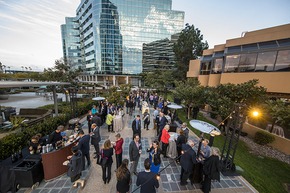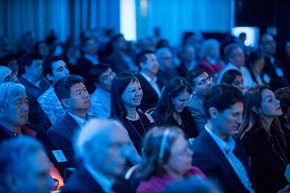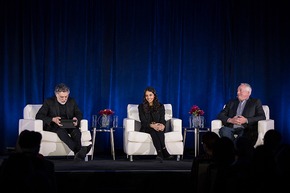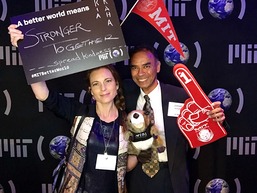Video: Better World Talks in SoCal Explore Environmental Solutions
-
-
Slice of MIT
Filed Under
What sets MIT students apart is a passion “to learn constantly,” and that doesn’t end with graduation, remarked Hashim Sarkis, dean of the MIT School of Architecture and Planning, at a recent event in Southern California. His audience—filled with alumni, along with parents of students and alumni and other friends of the Institute—illustrated his point as they spent an evening soaking up info about urban planning, climate modeling, nuclear fusion, and other ways MIT is advancing solutions to environmental challenges.
A pair of MIT Campaign for a Better World events, held on March 19 in San Diego (captured in the video above) and on March 21 in Los Angeles, gathered a total of more than 500 alumni and friends of MIT to hear talks by Sarkis; Meghana Ranganathan, a PhD student in the Department of Earth, Atmospheric, and Planetary Sciences; and Dennis G. Whyte, director of the MIT Plasma Science and Fusion Center.
W. Eric L. Grimson PhD ’80, MIT’s chancellor for academic advancement, delivered an introduction at both events. Additional welcoming remarks were offered in San Diego by Gary Eigen ’91, SM ’92, president of the MIT Club of San Diego, and in L.A. by Haejin Baek ’86, member of the MIT Corporation Development Committee and the Dean’s Advisory Council of the School of Engineering.
During the program, Sarkis cited research from his school that puts design thinking in service of sustainability—from self-assembling furniture that has the potential to eliminate packaging and waste, to the creation of new construction systems that can help cities adapt to rising water levels.
For Ranganathan, who described her experience visiting a melting glacier in Greenland, her background in applied mathematics and machine learning allows her to make a direct contribution to understanding climate change. “Increasingly, this is a problem that people like me need to help solve,” Ranganathan told the crowd. “If we can factor in fine-scale features in climate models, we’re one step closer to knowing what will happen in any city in 100 years. That will help shape our response to climate change around the world.”
Whyte explained the idea behind SPARC, the MIT project that aims to be the first fusion device to produce more energy than it consumes. Many of the ideas underpinning SPARC’s approach—such as the use of high-temperature superconductors for high-field, demountable magnets, and the advanced, robust, compact design—were developed in nuclear science and engineering classes at MIT.
The three presenters fielded questions from both California audiences. With each response, they provided evidence of the MIT commitment Grimson described in his introduction: taking serious challenges to the planet’s health as “invitations to action.”
In Whyte’s words: “This is a campaign about a better world. It’s a better world for now, but also it’s a better world for all the generations to come.”
With 20 Better World events complete, the tour is not over yet. Programs are planned this fall for Atlanta, on October 18, 2019, and in London, on November 8, 2019. Learn more and get involved at betterworld.mit.edu.














